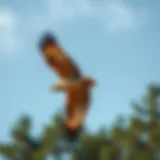Exploring Snowmobiling in Big Bear: An In-Depth Analysis


Intro
Snowmobiling in Big Bear, California, represents a unique intersection of recreation and environmental awareness. As winter blankets the region in snow, enthusiasts seek out the thrills and scenic beauty this activity offers. However, it is crucial to examine the broader implications of snowmobiling, especially concerning the local ecosystems and sustainable practices. This journey into the snowy landscapes also prompts reflections on conservation and the cultural significance of this activity within the community. The following sections will detail the environmental conditions, safety considerations, and gear recommendations specific to snowmobiling in Big Bear.
Understanding Woodland Ecosystems
The woodlands surrounding Big Bear are home to diverse ecosystems. These ecosystems have distinct characteristics and components that are worth exploring. This understanding can enhance the experience and responsibility related to snowmobiling.
Importance of Biodiversity in Forests
Biodiversity is foundational to healthy woodland ecosystems. A diverse range of plants and animals contributes to ecological balance and stability. In Big Bear, various species interact, creating a dynamic environment crucial for ecological health. Protecting this biodiversity becomes essential, especially as recreational activities increase. Snowmobiling, if improperly managed, might disrupt habitats. Therefore, awareness of local species and their habitats can inform safer and more responsible practices.
Role of Forests in Climate Regulation
Forests play a significant role in climate regulation. They act as carbon sinks, absorbing carbon dioxide from the atmosphere. In Big Bear, the forests help in maintaining local climate stability. As winter sports enthusiasts engage in snowmobiling, it is important to recognize that their actions can impact these larger climate functions. Understanding this relationship encourages responsible behavior, ensuring activities do not contribute to degradation of the environment.
Sustainable Forestry Practices
As snowmobiling continues to draw attention, integrating sustainable practices into forest management becomes imperative. Sustainable practices aim to preserve the delicate balance between recreational activities and ecological preservation.
Principles of Sustainable Forestry
Sustainable forestry is about managing forest resources to meet current needs without compromising future generations. This includes:
- Minimizing environmental impact
- Promoting tree diversity
- Implementing proper land-use planning
These principles are not only applicable to timber harvesting but also to recreational activities like snowmobiling. Adopting such practices can help maintain the health of Big Bear's woodlands.
Case Studies of Successful Implementations
In various parts of California, successful case studies highlight sustainable forestry practices. For instance, collaborative efforts between local governments and conservation organizations have shown positive results in managing recreational use while preserving ecological integrity. These case studies often provide valuable insights into balancing recreation with environmental stewardship.
Woodland Stewardship Techniques
Effective woodland stewardship is essential to maintain the delicate ecosystems within Big Bear. Implementing robust management plans can enhance both recreation and conservation efforts.
Forest Management Plans
Forest management plans outline strategies to monitor and manage forest health. These plans can include seasonal restrictions on snowmobiling routes to protect sensitive areas. This approach balances the needs of enthusiasts with the needs of the ecosystem, fostering a mutually beneficial relationship.
Conservation Strategies
Various strategies can be implemented to protect woodland ecosystems. These may include:
- Establishing wildlife corridors
- Designating protected areas
- Educating snowmobilers on responsible practices
Promoting awareness and providing guidelines can minimize the impact of snowmobiling on local wildlife.
“Understanding the environmental context of recreational activities helps shape more responsible behavior, ensuring that enjoyment does not come at the expense of nature.”
Preface to Snowmobiling
Snowmobiling is not just a recreational activity; it serves as a gateway to exploring and engaging with winter landscapes. In the context of this article, understanding snowmobiling lays the groundwork for a broader analysis of the experience in Big Bear, California. This section covers defining the sport and detailing its appeal, shedding light on the complexities and considerations surrounding this winter pastime.
Defining Snowmobiling
Snowmobiling involves riding a motorized vehicle designed for travel on snow. These machines have evolved significantly since their inception, growing in versatility and sophistication. A snowmobile typically features skis at the front and a track at the rear, allowing it to glide over snowy terrain. The sport encompasses various forms of riding, from leisurely trails to adrenaline-inducing backcountry adventures.
While the primary purpose is recreation, snowmobiling can also be utilitarian. Some users depend on these vehicles for winter transportation, hunting, or accessing remote locations that are difficult to navigate otherwise. In essence, snowmobiling transcends mere leisure; it connects people with the natural world in colder months, emphasizing both adventure and functionality.
The Appeal of Winter Sports
Winter sports, including snowmobiling, attract many enthusiasts for several reasons. The allure of snow-covered landscapes combined with the thrill of maneuvering a powerful machine provides a unique combination of excitement and escape.
- Connection with Nature:
Being outdoors in the winter allows enthusiasts to experience serene environments. Snow-covered mountains, frozen lakes, and pristine forests create a picturesque backdrop that captivates participants. - Sense of Freedom:
Snowmobiling offers a feeling of liberation as riders navigate through various terrains. The speed and agility of the machines enhance this sense of unrestricted movement. - Social Interaction:
The community aspect is significant. Snowmobiling often occurs in groups, fostering camaraderie among participants. Local events and competitions bring like-minded individuals together, strengthening community bonds. - Adventure and Challenge:
Many snowmobile riders seek adventure. The challenge of navigating different terrains and conditions provides adrenaline-fueled excitement. - Seasonal Enjoyment:
For those who love winter, snowmobiling serves as a way to enjoy the colder months instead of dreading them. It makes winter a season of activity rather than inactivity.
In summary, snowmobiling holds a special place in the hearts of winter sports enthusiasts. It marries the thrill of speed with the serenity of nature, making it an appealing choice for outdoor recreation. Understanding its definition and allure provides a foundational context for further exploration of snowmobiling in Big Bear.
Overview of Big Bear


Understanding Big Bear is crucial for those interested in snowmobiling. This area is not just a destination, but a unique environment that shapes the experiences and safety concerns of those who venture into its snowy terrains. Big Bear boasts a variety of geographical features, such as mountains, forests, and lakes, that significantly enhance its appeal as a winter sports hub. Knowing how these elements interact with snowmobiling can help riders prepare better and enjoy their excursions fully.
Geographical Features
Big Bear Valley has an elevation of about 6,800 feet, making it one of the higher elevations in Southern California. This altitude impacts snow accumulation. Higher elevation means more snowfall, providing a robust foundation for snowmobilers.
The surrounding mountain ranges, including the San Bernardino Mountains, provide stunning views and challenging terrains for riders. Riders can find diverse landscapes that range from open meadows to heavily wooded areas. Such variance offers different experiences depending on individual skill levels and preferences.
Additionally, Big Bear Lake itself adds to the geographical complexity. While snowmobiling on the lake may be restricted, its proximity to snow-covered trails is beneficial. Riders can enjoy a mix of trail types depending on their preferences where one can find flatter and more accessible paths alongside deeper, more technically challenging tracks, making it suitable for both beginners and seasoned enthusiasts.
Climate Conditions
The climate in Big Bear plays a key role in snowmobiling activities. Winters are generally cold, characterized by significant snowfall between November and March. These conditions create an ideal environment for snowmobiling. The average snowfall can exceed 100 inches in a season. However, weather patterns can vary.
Understanding these variations helps snowmobilers plan their outings more effectively. Temperatures can drop drastically at night, affecting snow quality by morning. Experts recommend checking weather forecasts regularly. A snow base of at least two feet is often ideal for safe and enjoyable snowmobiling.
Riders must also consider potential weather changes. Sudden storms can create poor visibility and treacherous conditions, making knowledge of local weather patterns essential. Having flexible plans and awareness of how weather can impact trails is vital for both safety and enjoyment.
"Knowledge of geographical and climatic conditions can serve as a major enhancement to the snowmobiling experience. By preparing for what to expect, enthusiasts can maximize their enjoyment and safety."
Types of Snowmobiles
Understanding the types of snowmobiles is crucial for both new and seasoned enthusiasts. Different models cater to varying needs, preferences, and conditions, which ultimately enhances the snowmobiling experience. The right choice can lead to safer outings, more fun, and better performance across diverse terrains. Here, we will explore two primary categories: recreational and touring models, along with factors to consider when choosing a snowmobile.
Recreational vs. Touring Models
Recreational snowmobiles are designed primarily for those who enjoy leisure and shorter rides. These snowmobiles typically have lighter frames and offer greater maneuverability, making them ideal for trails and play areas. Users seeking excitement on varied terrains might prefer these models. Features often include sporty designs, responsive handling, and an emphasis on speed.
In contrast, touring models provide a different purpose. Designed for longer trips, they offer comfort and stability over extended periods. This type of snowmobile generally includes enhanced seating, larger fuel tanks, and added storage options for gear. While they may handle less aggressively compared to recreational models, their strength lies in efficient travel across large distances.
"Choosing between recreational and touring snowmobiles largely depends on your riding intentions and preferences."
Snowmobilers should work to understand their personal use cases before making a decision. The model type impacts ride quality, comfort, and capability on various trails. Being aware of these differences ensures that users get the most out of their investment.
Choosing the Right Snowmobile
Selecting the right snowmobile involves several considerations. First, assess your riding experience. Beginners might want to start with easier-to-handle recreational models, which provide a learning curve without overwhelming complexity. In contrast, skilled riders might lean toward models that offer advanced capabilities.
Another important factor is the terrain where you will predominantly ride. Mountainous terrains may necessitate snowmobiles equipped with specific features such as power and maneuverability. Flatlands might allow more options since speed and jetting features could take precedence.
Moreover, factors such as engine size, weight capacity, and fuel efficiency will also play significant roles. For those interested in going off-trail, checking for shocks, tracks, and skis appropriate for such activities is vital. Conducting thorough research into make and model options can help narrow down the choices.
Lastly, consider additional amenities that might enhance your experience. Features like heated grips, comfortable seating, and built-in navigation systems can significantly impact your enjoyment and ease during rides. Understanding these aspects before settling on a purchase can lead to more satisfying outings in Big Bear's snowy landscapes.
Safety Protocols in Snowmobiling
Safety protocols are paramount in snowmobiling, not just for individual riders but also for the conservation of the environment and local ecosystems. This section outlines essential safety measures that can enhance the experience and ensure the well-being of both the riders and native wildlife. Understanding these protocols shapes the responsible conduct expected in the snowy terrain of Big Bear.
Essential Safety Gear
Equipping oneself with the right safety gear is critical in snowmobiling activities. The correct gear minimizes risks and can prevent injuries in adverse situations. Essential items include:
- Helmet: A certified safety helmet is an absolute must. It protects the head from potential impacts during accidents. Look for helmets with ventilation and fog-resistant visors to ensure clear visibility in snowy conditions.
- Goggles: Protecting the eyes from snow, ice, and wind is crucial. Goggles should provide UV protection and have anti-fog features.
- Clothing: Dress in layers to adapt to changing temperatures. Waterproof and windproof outer layers help keep the body dry and warm.
- Gloves: Insulated gloves maintain dexterity while keeping hands warm in frigid temperatures.
- Boots: Waterproof, insulated boots with good traction are necessary to prevent slips and keep feet warm.
- Reflective Gear: In low visibility situations, wearing reflective gear enhances safety by making the rider more visible.
Beyond personal protection, carrying emergency gear is also advisable. Items such as a first aid kit, flashlight, snacks, and a map or GPS device can be invaluable in case of an emergency.
Navigating the Terrain
Navigating the diverse terrain of Big Bear requires skill and attentiveness. Snowmobilers must be aware of both their riding capabilities and the surrounding environment, which can be challenging due to snow depth and varying weather conditions.
Key considerations include:
- Understanding Trail Markings: Familiarize yourself with trail maps and signs. Stick to designated paths to avoid damaging the landscape and disturbing wildlife habitats.
- Assessing Conditions: Weather can change rapidly. Be aware of snow conditions and potential hazards like avalanches. Check weather forecasts before heading out.
- Adapting Riding Techniques: Depending on the terrain—whether it's uphill, downhill, or through wooded areas—modify your speed and steering accordingly. Stay alert for obstacles, including rocks or fallen trees, covered by snow.
- Group Riding: When riding in a group, maintain a safe distance between riders to prevent collisions. Establish a meeting point in case someone gets lost or is delayed.
- Wildlife Awareness: Keep a lookout for wildlife. Snowmobiles can unintentional disturb animals, particularly those that may be hibernating or nesting during winter months.
By adhering to safety protocols, snowmobilers can protect themselves and preserve the delicate balance of Big Bear’s ecosystem while enjoying this invigorating winter activity.
Environmental Impact of Snowmobiling
Snowmobiling in Big Bear presents a unique opportunity to explore natural landscapes. However, this pastime carries ecological ramifications that require careful consideration. Understanding these impacts is crucial for enthusiasts and conservationists alike. This section will delve into the effects of snowmobiling on local ecosystems and propose sustainable practices to mitigate negative outcomes.
Effect on Flora and Fauna


Snowmobiling can influence both plant and animal life in significant ways. The primary concern lies in the disruption of habitats. The loud noise and physical presence of snowmobiles may disturb wildlife, especially during critical breeding seasons. Research has shown that animals may be more likely to flee from their habitat, which affects their feeding and breeding behaviors.
For instance, certain species may abandon their nesting sites due to snowmobile traffic. Additionally, the physical tracks left in the snow can disrupt natural processes for plant life, particularly in sensitive areas. This can lead to changes in plant communities that may take years to recover.
Consider the following effects of snowmobiling on local wildlife:
- Displacement of animals: As mentioned, many species may leave their habitats temporarily or permanently.
- Vehicle collisions: Accidents can result in significant fatalities for various wildlife, particularly on trails intersecting migration paths.
- Erosion: Repeated snowmobile use can lead to soil compaction, affecting vegetation growth.
Conservation efforts must focus on minimizing these impacts by promoting responsible riding practices. Education on wildlife sensitivity and habitat protection is essential for snowmobilers.
Sustainable Practices in Recreation
The sustainability of snowmobiling relies on adopting best practices that lessen environmental footprints. Embracing green technologies in snowmobiling is vital. Manufacturers are increasingly developing electric snowmobiles that reduce emissions significantly. This shift would benefit not only air quality but also the overall experience for riders, as quieter machines would lead to less disruption for wildlife.
Additionally, snowmobiling clubs and local organizations play a crucial role in promoting sustainable practices. Here are some key strategies:
- Establishing designated trails: Properly maintained and marked trails can reduce off-trail riding, minimizing habitat disruption.
- Eco-friendly trails: Building trails using sustainable materials can help maintain natural landscapes while supporting recreational activities.
- Awareness campaigns: Engaging and educating the community and riders about the impact of snowmobiling on the environment can lead to more informed decision-making.
To summarize, while snowmobiling can adversely affect the environment, adopting more sustainable practices can help mitigate these impacts. With the right approach, it is possible to enjoy this activity while preserving the beauty Big Bear offers. By balancing recreation and conservation, snowmobilers can ensure that future generations can experience the joy of exploring the winter landscape.
Local Regulations and Guidelines
Understanding the local regulations and guidelines for snowmobiling in Big Bear is essential for both enthusiasts and casual riders. These regulations not only ensure users enjoy their sport safely but also protect the delicate ecosystems within the area. Compliance with these guidelines is not just a suggestion; it’s a necessity for preserving the beautiful landscapes and wildlife that attract many visitors to the region.
Permits and Licensing
Before venturing out on the trails, obtaining the necessary permits and licenses for snowmobiling is crucial. In California, the requirement for a snowmobile registration varies depending on the type of vehicle. Riders must register their snowmobiles through the Department of Motor Vehicles (DMV). Proper registration helps maintain accountability and ensures that trails are used responsibly.
Additionally, some areas may require seasonal permits, especially in protected zones. The availability of these permits might change based on weather conditions and environmental considerations.
Below are some key points regarding permits:
- Registration: Ensure your snowmobile is registered with the DMV.
- Trail Access: Some trails may require additional permits or fees.
- Seasonal Variations: Check for updates on permits due to shifting environmental policies.
Restrictions and Protected Areas
Several restrictions are put in place to safeguard sensitive environmental regions and promote responsible snowmobiling. Certain areas in Big Bear are designated as protected zones, where snowmobiling is either limited or prohibited entirely. These restrictions are crucial for conserving wildlife habitats and maintaining the ecological balance.
Here are notable restrictions to keep in mind:
- Access Limitations: Not all areas are open for snowmobiling. Always verify if a specific trail or area permits snowmobiling before planning your trip.
- Wildlife Conservation: Keep a safe distance from wildlife sightings and respect their natural habitats. Avoid traveling through areas known for nesting birds or habitats of endangered species.
- Weather Considerations: Seasonal restrictions might be imposed based on snowfall levels or environmental impact assessments.
"Understanding and adhering to local regulations fosters a sense of community among snowmobilers while preserving the environment for all to enjoy."
Cultural Significance of Snowmobiling in Big Bear
Snowmobiling holds a unique place within the cultural fabric of Big Bear, influencing not only recreational habits but also community identity. This winter sport serves as a bridge between individuals and their environment, fostering a deep appreciation for the mountain landscape. The culture surrounding snowmobiling is not merely about speed and thrill; it intertwines history, community, and celebration, making it a vital part of life in this region.
Historical Context
Historically, snowmobiling has roots that trace back to the early developments of winter transportation. In Big Bear, this activity began to gain prominence from the mid-20th century when snowmobiles became more accessible to the general public. The sport provided local residents and tourists an opportunity to explore the mountainous terrain during winter months, which were once seen as inhospitable. Over the years, snowmobiling has evolved from a utilitarian mode of transport to a recreational pursuit characterized by freedom and adventure.
The impact of snowmobiling is evident in the growth of local businesses that cater to enthusiasts. Rentals, maintenance services, and specialized gear shops have flourished, contributing to the economy and establishing a recognizable snowmobiling ecosystem. Furthermore, snowmobiling has played a role in shaping the winter tourism season in Big Bear, attracting visitors from various regions. This seasonal influx has cemented the sport’s status as both an economic driver and a cultural event.
Community Events and Competitions
In addition to its historical backdrop, snowmobiling fosters strong communal ties through events and competitions. Big Bear hosts various prominent events that bring enthusiasts together, showcasing skills and camaraderie. For instance, annual snowmobile races attract competitors and spectators alike, uniting local residents and tourists in friendly rivalry.
Events like snowmobiling festivals not only promote the sport but also celebrate the community. These gatherings often include demonstrations, safety workshops, and fun activities for families. Participants have the chance to connect with one another, share their experiences, and build friendships that transcend the sport itself. Such events bolster community spirit and underline snowmobiling's role as a social activity, creating a sense of belonging amongst diverse groups.
Snowmobiling is not merely a sport; it connects people and fosters local culture in profound ways.
Snowmobiling Trails in Big Bear
Snowmobiling trails are essential for the experience of navigating the snowy landscapes of Big Bear. These trails not only serve as routes for enthusiasts but also connect riders to the heart of the region's winter charm. Each trail offers unique characteristics and challenges, providing opportunities for both recreation and exploration. Understanding the offerings of these trails is crucial for anyone aiming to maximize their experience while ensuring safety and compliance with local regulations.
Most trails in Big Bear are designed to accommodate a range of skill levels, facilitating accessibility for beginners and seasoned riders alike. The versatility of the trail system supports a wide demographic. Riders can take exhilarating paths that wind through dense forests, open fields, and rugged mountain terrain.
Furthermore, these trails are critical for the surrounding community as they attract visitors. More foot traffic helps local businesses sustain their livelihood and enhances community engagement in promoting winter sports.


Popular Trails Overview
Big Bear features a variety of trails, each with distinct appeal. Here are some noteworthy trails:
- Polique Canyon Trail: This trail offers a blend of scenic views and moderate challenges, making it suitable for riders with some experience. Riders can enjoy expansive views of the surrounding mountains and valleys.
- Gold Mountain Trail: Suitable for advanced riders, this trail presents technical challenges and steep inclines. The panoramic vistas at certain points make the effort worthwhile.
- Sweetwater Trail: Primarily for newcomers, it features gentle slopes and is well-marked. This makes it a perfect training ground for those just starting.
- Lake Arrowhead Trails: Though not exclusively in Big Bear, these trails are popular among adventurous riders seeking neighboring areas. They offer diverse terrain and scenic experiences.
These trails not only differ in their natural beauty but also in the adventure they provide. Exploring them enriches the snowmobiling experience.
Difficulty Levels and Recommendations
Understanding the difficulty levels of snowmobiling trails is vital for ensuring safety and enjoyment. Each trail in Big Bear serves different skill sets. Here’s a simplified breakdown:
- Beginner Trails: These trails have gentle slopes and minimal technical requirements. It’s recommended for those who are new to snowmobiling. Recommended practice is that beginners ride in groups and always stay within marked paths.
- Intermediate Trails: These configurations present moderate challenges, including sharper turns and varied terrain. Riders should have basic skills and comfort with their snowmobiles. Equipment checks should be routine before entering these trails.
- Advanced Trails: Advanced trails embody steep climbs, technical features, and variable conditions. It is essential that riders possess experience. An important caution here is to never ride alone; sharing the experience ensures safety and preparedness for challenges.
When choosing a trail, always consider weather conditions and personal skill levels. This practice optimizes safety while enhancing the overall experience. Riders are also advised to carry snowmobile safety gear, as this is a fundamental part of preparedness.
Community Engagement in Snowmobiling
Community engagement in snowmobiling is crucial. It fosters not only a sense of belonging but also enhances the overall experience of snowmobiling in Big Bear. Connecting with other enthusiasts can lead to shared adventures and deeper understanding of the trails and the environment. Engaging with local clubs and organizations offers valuable information on events, trail regulations, and responsible practices without which individual bikers may struggle.
Moreover, organizations can mobilize resources to maintain trails and educate riders about environmental impacts. A strong community creates a network of support, where both novices and experienced riders can exchange tips and safety information. This engagement can result in better stewardship of the land, ensuring that the beauty and resources of Big Bear are preserved for future generations.
Local Organizations and Clubs
Local organizations play a pivotal role in shaping the snowmobiling landscape in Big Bear. These clubs provide a platform for riders to connect. Notable ones include the San Bernardino Snowmobile Club and the Big Bear Valley Trails Foundation. They host events, manage trail maintenance, and advocate for snowmobilers' rights.
Membership in these clubs often includes access to educational resources and safety workshops. Participating in organized rides also enhances safety as groups tend to be more vigilant. Additionally, many clubs engage in community outreach to raise awareness about snowmobiling's impact on the environment, promoting responsible riding practices.
A shared calendar of events keeps members informed about gatherings, races, and clean-up days, fostering camaraderie and active participation in environmental stewardship.
Volunteer Opportunities
Volunteering is another meaningful way community members can engage with snowmobiling. These opportunities traditionally include trail maintenance, teaching safety courses, and even assisting at local events. Volunteers help to keep trails operable and safe, which is essential for the enjoyment of all riders.
From an environmental standpoint, volunteering in clean-up activities not only improves trail conditions but also educates participants about ecological responsibility. Those interested can find opportunities through local clubs or organizations, often advertised on their websites or community boards.
Moreover, volunteering strengthens relationships among community members. It connects diverse individuals with a common interest in snowmobiling and the environment. Working together towards a common goal often leads to lasting friendships and partnerships, fostering a resilient community committed to preserving the natural beauty of Big Bear.
Future of Snowmobiling in Big Bear
The future of snowmobiling in Big Bear holds significant implications for enthusiasts, the local economy, and environmental stewardship. As technologies evolve and climate conditions shift, this recreational activity will face new opportunities and challenges. Addressing these advancements and adaptations is imperative for maintaining the balance between enjoyment and sustainability. This section aims to provide insights into the emerging technologies and strategies that will shape the future landscape of snowmobiling in Big Bear.
Emerging Technologies
Technological advancements in snowmobiling have the potential to enhance user experience, safety, and environmental impact. A few key elements warrant attention:
- Electric Snowmobiles: A shift towards electric propulsion is underway. These machines offer quieter operation, reduced emissions, and lower impact on local wildlife. Brands like Polaris and Arctic Cat are investing in electric models that are gaining traction among enthusiasts who prioritize eco-friendliness.
- Smart Technology Integration: Modern snowmobiles are being equipped with features such as GPS, collision avoidance systems, and advanced navigation tools. This integration helps riders make informed choices about routes and mitigates risks associated with unfamiliar terrain.
- Data Analytics: Utilizing data analytics can aid in better understanding trail usage patterns, which may foster improved trail maintenance and management efforts. These insights allow for crucial adjustments in both recreational policies and environmental conservation initiatives.
"Innovation in snowmobiling technology not only enhances the rider experience but also promotes a more sustainable approach to recreation in delicate environments."
Adapting to Climate Change
Climate change poses significant challenges to outdoor recreational activities, snowmobiling included. Strategies to adapt are essential for preserving this sport’s appeal in Big Bear. Key considerations include:
- Trail Management: With shifting snow patterns, it’s vital to develop adaptable trail systems. This may involve creating alternate paths or investing in snow-making technologies to extend the season. Having flexible management practices will be key to navigating changing climates.
- Monitoring Ecosystems: Implementing monitoring systems to track the health of flora and fauna near snowmobiling areas can help mitigate negative impacts. Understanding ecosystem changes allows for informed adjustments in guidelines and policies.
- Community Involvement: Engaging local communities in conservation efforts will be important. Initiatives that encourage users to adhere to environmentally friendly practices can lessen the overall footprint of snowmobiling in Big Bear and promote sustainability.
In summary, the future of snowmobiling in Big Bear is closely linked to technological innovations and adaptive strategies. Awareness and action regarding these factors can empower the community to foster a sustainable and enjoyable snowmobiling experience.
The End
In any comprehensive analysis of snowmobiling in Big Bear, the conclusion serves as the critical section that encapsulates the entire discourse. This area of focus allows us to reflect on the myriad of interactions between enthusiasts, environmental considerations, and community implications surrounding this popular winter activity. Summarizing the insights gleaned from various sections, the conclusion highlights essential elements such as safety, sustainability, and the continuous need for education in responsible riding.
Snowmobiling, while exhilarating, carries with it an obligation to protect the natural environment. Awareness of the ecological impact is essential for maintaining the balance between recreation and conservation. The need for sustainable practices is paramount. As we recapitulate, we emphasize all actors in this arena must prioritize ecosystem health to ensure the longevity of snowmobiling as a winter sport in Big Bear.
Recap of Key Insights
The preceding discussions have illuminated several critical factors:
- Environmental Impact: The effects on flora and fauna require consideration, as improper practices can disrupt local ecosystems.
- Safety Protocols: Understanding essential gear and navigation techniques is imperative to minimize injuries and enhance the overall experience.
- Local Regulations: Compliance with permits and restrictions protects both riders and the environment, fostering a culture of responsibility.
- Community Engagement: The involvement of local organizations and clubs bolsters a supportive network for enthusiasts while fostering an appreciation for outdoor activities.
"It is essential that snowmobilers understand their impact and embrace sustainable practices."
The Path Forward for Enthusiasts
Looking ahead, snowmobiling in Big Bear stands at the crossroads of tradition and innovation. Enthusiasts must adapt to emerging technologies, such as electric snowmobiles, that could lessen environmental footprints while providing the thrill seekers demand. In addition, organizations must promote educational initiatives that emphasize responsible riding and the importance of adhering to best practices.
The topic of climate change is ever-present. Riders should remain aware of shifting weather patterns. Adaptability will be key as conditions evolve. Education on climate resilience can not only enhance the enjoyment of snowmobiling but also foster stewardship among the community.







